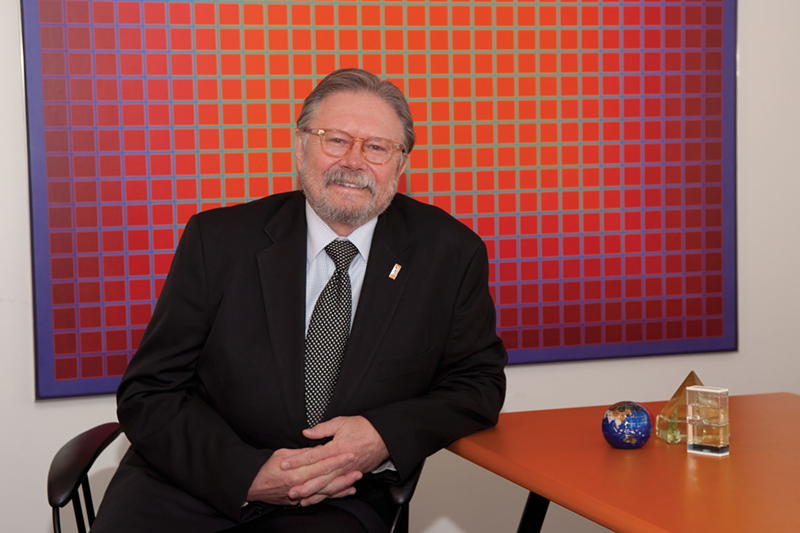D
oes an art academy founded in the 19th century have a place in today’s world? John Sullivan, new president of the Art Academy of Cincinnati, believes it does.
“Art-making is a marketable skill,” he says. “Branding, product design, other design fields need artists; some graduates go into the museum field, others become professional fine artists.”
Sullivan, whose voice carries a pleasant Southern tonality, arrived in February and has never before lived so far north as Cincinnati, except undergraduate years at Northwestern University in Illinois. Having lived in Arkansas, Louisiana and most recently Tennessee, he finds both a Southern and European feel to this city that is “very welcoming and hospitable.” The move is not complete; Sullivan’s wife still lives in their house near Nashville, where he previously was vice president for academic affairs and dean of the faculty at Watkins College of Art, Design & Film. His current Cincinnati housing is a loft on Clay Street, walking distance from the Academy. In a way, he says, this is a long-time dream — a loft in the city and house in the country — but the drive to Nashville is excessively long.
Over-the-Rhine’s atmosphere of life and activity is the source of its European feel for Sullivan, who also recognizes that people need to be reassured about safety. Access to the Academy is closely supervised and security staff will walk visitors to their cars if desired, but incidents have been minimal. Meanwhile, of course, theaters, restaurants and shops increasingly draw street traffic from all parts of the city to Over-the-Rhine.
College-level courses are not the only function of the Academy, particularly in summer when outreach is most intense. All year long “we try to fill the gap left by the public schools’ cut-back in what they consider extracurricular studies, but which are in fact very important parts of the curriculum,” Sullivan says. “We have affordable, top quality instruction, using the same studios as for our college level students.”
A brochure titled “Summer at AAC is Hot!” lists four- and eight-week undergraduate summer courses for credit or as continuing education beginning June 11, with a second four-week session starting July 9. Camp Art Academy, for 5- to 12-year-olds, has weeklong classes beginning June 11 and running through Aug. 27, except the week of July 4.
Visitors entering the Academy’s front door at 1212 Jackson St. might not realize they cross a threshold formed by a pair of stone steps rescued from the Academy’s former Eden Park home, but the inlaid slabs are a silent reminder of the institution’s long history.
The transfer to Over-the-Rhine in 2005 “was a good move for many reasons,” Sullivan says. “A giant conversion is underway. The Academy now is an urban institution, re-purposed. We have shed the old skin of ‘museum school.’ It’s a struggle, with a lot of moves both subtle and brash to get into the new skin. Academic innovation is a necessity. Young artists want to design skateboard graphics, T-shirts, make movies.”
In spring 2013, elementary courses in film and video will be introduced.
“We’re no longer teaching for avocation,” Sullivan says. “Sustainable skills are necessary to meet student expectations. The historical material is still available and works well with the new; they’re mutually supportive.”
Although another local publication reported the Academy is now debt-free, the actuality is that it’s mortgage-free. A portion of the Academy’s endowment paid off debt on the school’s two OTR buildings.
“Revenue from enrollment is not sufficient to cover costs. We’re less in the hole this year, and next year should be better. We’re hoping for a balanced budget by 2014,” Sullivan says.
The generous space available in those two buildings, filling the block along 12th Street between Jackson and Walnut streets, can accommodate twice or more than the 235 registered last fall.
“We’re hoping for 325 this fall,” he says, “and could handle 550 to 600 students.”
The total of 120,000 available square feet “is substantial for a school this size,” but 8,000 square feet in the main building and 13,000 square feet in the building next door have not yet been renovated. When needed, Sullivan says they have more than 20,000 more square feet to move into.
One problem, he says, is “the need to capture and hold affordable student housing. We want to be part of the development but recognize the danger of pushing residents out as the affluent move in. College students actually need the same kind of things — affordable places to eat and shop — as the earlier residents. The whole purpose of an urban institution is not to push out but to integrate. We want to retain the mix, with students integrated into it. It’s not desirable for students — or anyone — to have everything pushed out of the way and behind a black-iron fence.”
At 1212 Jackson St., the multi-floored space itself in what was once an industrial building is commodious, functional, brightly lit and seems to invite art-making within its own unadorned framework. Holding its own in Sullivan’s sun-filled corner office is a painting by former Academy faculty member and Op-artist Julian Stanczak. Significantly, the painting in this president’s office is not by Frank Duveneck, whose shadow as head of the Academy long colored succeeding reigns, but by a more recent famous artist who once taught there.
On the plus side, financially, is the waning need to maintain a heavy component of computer equipment.
“Now students carry their own tablets, smartphones, laptops, sometimes all three,” Sullivan says. “I envision a classroom as a place with wireless in the ceiling and comfortable seating, perhaps beanbag chairs. We no longer need chalk boards or to sit down at computers.
“We do need a wood shop, a room with easels, a model stand … those things will never go away.”
It is clear that the Academy’s new president, himself a painter and graphic artist, doesn’t expect art schools to go away either.






